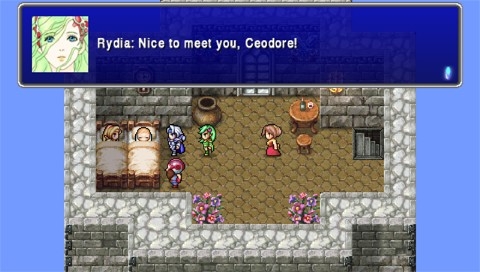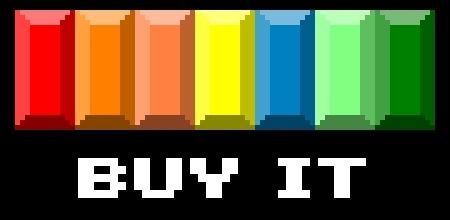
As its predecessor did to the series, The After Years brings new gameplay innovations to its universe. Most pervasive is the Moon system:as you spend nights in inns, tents, and cottages, the cycle of the moon changes from waxing, waning, new moon, and full moon. This has severe combat implications, as under one cycle, black magic may be stronger, but physical attacks are weakened. Additionally, more powerful monsters appear in certain locales when the moon is under a particular cycle, making them no-man’s land unless you’re up for a challenge. The end effect is that you can spend a few nights to your advantage in order to gain combat bonuses that are beneficial to your party. You can play through the game without getting too in-depth with this mechanic; it just adds a little variety to the flow of battles.
Also introduced are Bands, where two characters can team up Chrono Trigger style to execute a united assault on the enemies. Ironically, I believe one of them is actually called Cross-slash, but it also involves dual casting as well as casting and bashing. This isn’t really a game changer; in fact, I rarely touched them, but it does add enough of a layer to emphasize that this is a new game and not just a rehash for sweet cash.
Like its source material, The After Years is not without its faults, but balance isn’t one of them this time. I would actually posit that The After Years is a far better balanced game than FFIV, presenting a more substantial challenge throughout (although I did have enough money to just stock up on X-Potions and skate by with melee attacks in the final sequence). The problem is that while the classic FF dungeon crawl (exploring caves where you can take detours to get items) is already starting to get old in the original game, it’s just plain outdated in The After Years. As much of the game involves this mundane spelunking (indeed, the “game” aspect of the title is pretty much dungeon crawling), the title begins to overstay its welcome when its playtime extends far beyond how long it took to complete FFIV. While the scenario is wonderful and new, the gameplay side isn’t, and it starts to undermine the sum of its parts as a game you arguably shouldn’t take seriously.
That may be a little harsh, but the final chapter drives this part home better than anything. The last sequence involves a dungeon about the size of the final dungeon in FFIV, in which you fight nearly every smaller boss from that game. Afterwards, you’re taken to smaller elemental variants on this setting, as you once again defeat each of the elemental fiends. Afterwards, you proceed through a new high-tech locale, where you defeat the CPU operating the Tower of Babil. Then you muck through an extremely open-ended Feymarch recreation where you track down Bahamut and Ashura. Lastly, you start the trek down a 30-level final area filled with a surprisingly large turnout of the major bosses from the first six FF games. I’m not ashamed to admit that I turned away from the prospect of completing the final episode, having felt satisfied that I’d seen everything there is to come. There have been a lot of great final dungeons in Square Enix games, especially in the 2D ones, but this isn’t one of them. It either shows an overindulgence in the dungeon crawl formula or an incompetence at what makes a solid final RPG level. No matter the case, it’s not fun, and it wasn’t for a long time before you get there.

In all fairness, this was originally an episodic game for mobile phones and later the Wii, so I could see how the formula may be more effective if it were played after waiting months for the next one. But as a stand-alone PSP game, it’s fairly monotonous and doesn’t lend itself to longer sessions like the recent Gods Eater Burst or Tactics Ogre: Let Us Cling Together do (see for yourself)
The Collection
As a whole, the collection brings a lot of cool things to each game that are worth talking about on their own.
First, this game borrows heavily from the previous PSP remakes of Final Fantasy I and II. The art style is very similar and some of the effects are the same as well. The little details of the environment and art assets are all much more detailed than the GBA version, and some effects such as shadows and sunbeams over desert towns actually add quite a lot to the experience. The character portraits are, unfortunately, somewhat ugly. The original Amano artwork seems to have been forgone in favor of the new artist brought on for the Nintendo DS remake and The After Years, but it doesn’t get in the way of the gameplay by any means. The last notable feature of the graphics is that the battle effects are, at times, downright amazing. Casting Firaga causes a beautiful cascade of fire to reach across the enemy’s side of the scene, showing that Square Enix is a developer very familiar with, and an expert in exploiting, the quality of the PSP’s screen.
The game has also received an updated translation that brings it more in line with the original Japanese and the newer FF vocabulary at the same time. “Spoony bard” is still in here, but the game has a more erudite and darker tone than the original localization. It also incorporates newer terminology, such as referring to the summons as Eidolons. The Land of Summons is now called the Feymarch, and the Bomb Ring Cecil transports early in the game is now referred to as some kind of sigil. It’s all more coherent now, and when you combine the visuals with the translation, this is very possibly the definitive version of Final Fantasy IV.
The gameplay, unfortunately, gets some odd effects from the new Auto battle feature. Pressing select during the battles turns “Auto” on, where all your characters will perform phsyical attacks on the default target, and the battle runs at a much faster speed. This is a lot like turning up the speed on an emulator when you’re trying to skip repetitive and easy battles, so it gives you less incentives to pirate rather than buy. But the difficulty appears to be lowered in FFIV, and the addition of Auto really reveals just how little you want to do with the battle system after a while. Because of the aforementioned reliance on tedious dungeon crawls, the feature actually makes the game seem a lot uglier than it actually is, with you hitting the Auto button almost all the time, and always to speed past the lengthier spell animations.
One feature, however, cannot be denied for how incredibly awesome it is, and that’s the music option in the menu. In any of the three games, you can choose between the new PSP arrangement, or the original score, with SNES filters and everything. Many times I’ve played for several hours with the original arrangement, losing myself in the nostalgia of a time long past, until realizing that I wasn’t playing with the new score, and would switch to enjoy that for a while. As much of an old school purist I may be, it cannot be understated just how fantastic the new score is. The songs have many little things in them that greatly add to the piece, and some of them bring to life the Irish influences composer Nobuo Uematsu incorporated into the game and elaborated on in the Final Fantasy IV Celtic Moon soundtrack.
There are many other smaller additions here that add to the package as a whole. For one, the battle transitions include the pixel-blurring of the 16-bit original, the swirling of the PlayStation era, and the glass breaking from Final Fantasy X, giving you a nice mix of the past, recent past, and current style of Final Fantasy. There’s also a part of the menu where you can unlock and view a large amount of concept artwork, although it’s kind of blurry (and not the hi-res artwork promised in the PlayStation Blog’s Empty Promises Tour 2011). Despite many wrinkles in the face of the game system, Final Fantasy IV: The Complete Collection brings enough new features along with the games in order to make it a respectable package.
Again, these games are not beyond criticism. The most disparaging factor of Final Fantasy IV has been the passage of time since its release, and The After Years relentlessly clings to ancient cliches. But RPG fans will still find the former to be a classic and have a blast playing through the latter. At this friendly price, it absolutely has a space in any FF fan’s library, especially those who haven’t played IV or The After Years. In fact, this is the go-to version for gamers who have yet to play IV in one of its many iterations. The only factor inhibiting its spot on the shelf is the fact that the game has largely been surpassed by a slew of PSP RPGs in recent memory.

Review Disclosure: A review copy of Final Fantasy IV: The Complete Collection was provided by Square Enix for the purposes of this review.






